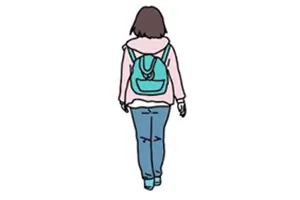
One of the most frequent questions I receive concerns weighted vests – ‘Should I buy one? Which one is best? Will it make a difference in my bone density?’ These questions seem to have multiplied recently because weighted vests, for some reason, are very popular right now. Nevertheless, I assure you that they are not trending because of new research touting their benefits.
Despite what we might read in the media, including from some bone health professionals (who sell these products on their website), the evidence for strengthening our bones by wearing a weighted vest remains uncertain. I have found this frustrating because it seems intuitive that they should work. I want them to work! But before I can enthusiastically recommend them, the science behind them must be much more conclusive.
Here are the facts:
What is a Weighted Vest?
A weighted vest is a wearable device that adds external resistance, typically in the form of sand or metal bars that are distributed across the torso. The weight and fit (via straps) are sometimes adjustable. These products are not new but have recently been gaining more attention for their possible role in bone health.
How Might Weighted Vests Help with Bone Density?
Our bones are highly responsive to mechanical stress. When you apply force to bones during activity, it stimulates bone cells called osteoblasts that are responsible for building new bone. This is called osteogenesis. Weight-bearing exercise that involves impact or resistance, is known to stimulate osteogenesis and support bone strength.
Theoretically, weighted vests amplify this effect by increasing the load on our skeleton. This adds to the mechanical stimulus on bones, helping to promote growth.
What Does the Evidence Show?
The evidence on both sides of this question is quite limited. There are some peer-reviewed studies that support the use of weighted vests for bone health, but unfortunately many of them are outdated, (> 25 years), and more than a few include a very small number of subjects. Not all are methodologically sound; for example, in one commonly cited study, no control was used.
Citations 1-4 at the bottom of the page identify almost every study done since the year 2000 that found some benefit. The most frequently cited study is the one from the year 2000 by Snow and colleagues. Those promising results have never been reproduced. Citations 5 and 6 are studies that show no effect on bone health, including a study just published last month.
My Advice?
If you already have a weighted vest and have no problems using it, go ahead and continue. It may be a valuable addition to your exercise routine. If your vest has the option of increasing the amount of weight, do so very gradually to avoid injury. A total of 5 to 10% of your body weight is the general rule of thumb. Keep in mind that paying attention to your postural alignment while wearing it is essential to get the most possible benefit and avoid injury.
If you do not have a vest but want one, it is not necessary to break the bank. There are some vests currently selling for close to $300.00, which in my opinion is excessive. Look for a vest that is adjustable for both weight and fit and sits close to the body. You don’t want something that will annoyingly shimmy around you as you move, OR one that looks bulky and will be hot in warmer weather.
As an alternative, consider using a very small backpack with a bottle of water to provide resistance. Water is heavy, (1 liter = about 2.2 lbs), and offers a convenient medium for gradually increasing the resistance that you can safely tolerate. This is what I do because I have not found a weighted vest currently on the market that I really like. (That’s why the image associated with this blog is a backpack and not a vest!) If you go this route, fit the pack so it sits well above your waist and start with one small bottle of water.
I do not recommend a weighted vest or backpack if your osteoporosis is severe, if you have vertebral fractures, or if your balance is poor.
In conclusion:
More well-designed studies are needed to create standardized protocols and show long-term effects. However, when used correctly, weighted vests or backpacks may be a valuable adjunct to your existing program.
I hope to see you in Strong Bones class!
Studies that show a benefit:
1.Hakestad KA, et al. Exercises Including Weight Vests and a Patient Education Program for Women with Osteopenia: A Feasibility Study of the OsteoACTIVE Rehabilitation Program. Journal of Orthopaedic and Sports Physical Therapy 2015 February;45(2).
# of subjects 31, no control group
2.Klentrou P, et al. Effects of Exercise Training with Weighted Vests on Bone Turnover and Isokinetic Strength in Postmenopausal Women. Journal of Aging and Physical Activity 2007;15(3):287-299.
# of subjects 16
3.Jessup JV, et al. Effects of Exercise on Bone Density, Balance, and Self-Efficacy in Older Women. Biological Research for Nursing 2003;4(3):171-180.
# of subjects 18
4.Snow CM, et al. Long-term Exercise Using Weighted Vests Prevents Hip Bone Loss in Postmenopausal Women. The Journals of Gerontology: Series A, 2000; 55(9):489-491.
# of subjects 18
Studies that do not show any benefit:
5.Beavers KM, et al. Weighted Vest Use or Resistance Exercise to Offset Weight Loss–Associated Bone Loss in Older Adults: A Randomized Clinical Trial. JAMA Network Open 2025;8(6):e2516772.
# of subjects 150
6.Greendale GA, et al. A Randomized Trial of Weighted Vest Use in Ambulatory Older Adults: Strength, Performance, and Quality of Life Outcomes. Journal of the American Geriatrics Society 2000; 48(3), 305-11.
# of subjects 62

